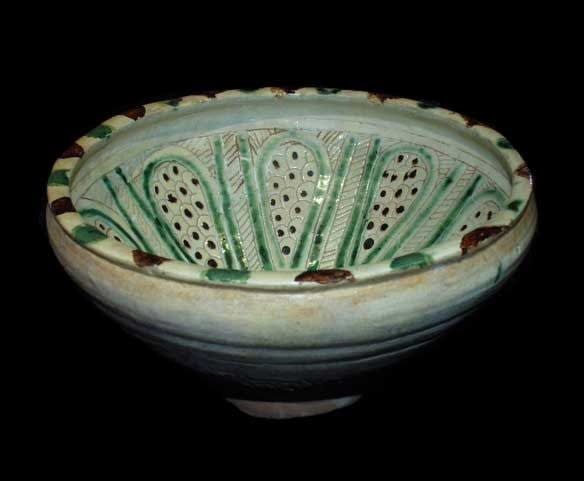Bamiyan Splashed 'Sgraffiato' Dish, 1100 CE - 1200 CE
Earthenware
JB.1284
This stunning Bowl has decoration incised (hence “Sgraffiato”) through a white slip, with lively coloring in various shades of brown, purple and green bringing a warm ethnic energy to the...
This stunning Bowl has decoration incised (hence “Sgraffiato”) through a white slip, with lively coloring in various shades of brown, purple and green bringing a warm ethnic energy to the piece, under a transparent glaze. The main decorative motif is a geometric rosette made up of eight palmettes each of which is separated by a vertical incised line. Each palmette is incised with a decorative “pine-cone” design that gives the piece a very organic feel. The greater body of the piece is decorated in a similar style but in larger size. The entire bowl is highlighted in green with additions of intermittent splashes of purple and green on the rim.
The incised wares of Eastern Ancient Iran (present day Afghanistan) have only emerged in fairly recent archeological publications. They represent a very widespread and diverse manufacture. Significant quantities have survived in very good condition, like the associated fritwares.
This bowl has a steeply sloping cavetto and resembles those first reported from the site of Bamiyan (see Gardin, 1957; especially pls 2-3). Its form and decoration are closely related to metalwork. This bowl distinguishes itself by its similarity to the originally published examples and rests on a molded foot.
For comparable examples see Oliver Watson, Ceramics from Islamic Lands, cataloging the Al-Sabah Collection in the Kuwait National Museum, 2004.
Also Earnst J. Grube, Cobalt and Lustre, The Nasser D. Khallili Collection of Islamic Art, 1994.
The incised wares of Eastern Ancient Iran (present day Afghanistan) have only emerged in fairly recent archeological publications. They represent a very widespread and diverse manufacture. Significant quantities have survived in very good condition, like the associated fritwares.
This bowl has a steeply sloping cavetto and resembles those first reported from the site of Bamiyan (see Gardin, 1957; especially pls 2-3). Its form and decoration are closely related to metalwork. This bowl distinguishes itself by its similarity to the originally published examples and rests on a molded foot.
For comparable examples see Oliver Watson, Ceramics from Islamic Lands, cataloging the Al-Sabah Collection in the Kuwait National Museum, 2004.
Also Earnst J. Grube, Cobalt and Lustre, The Nasser D. Khallili Collection of Islamic Art, 1994.
7
of
7
